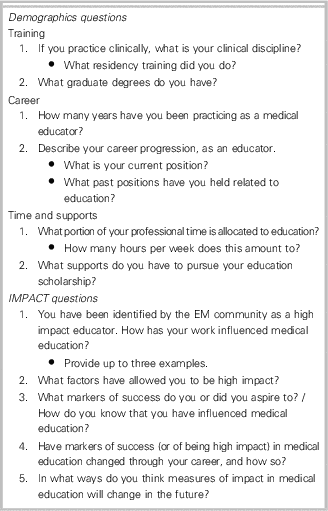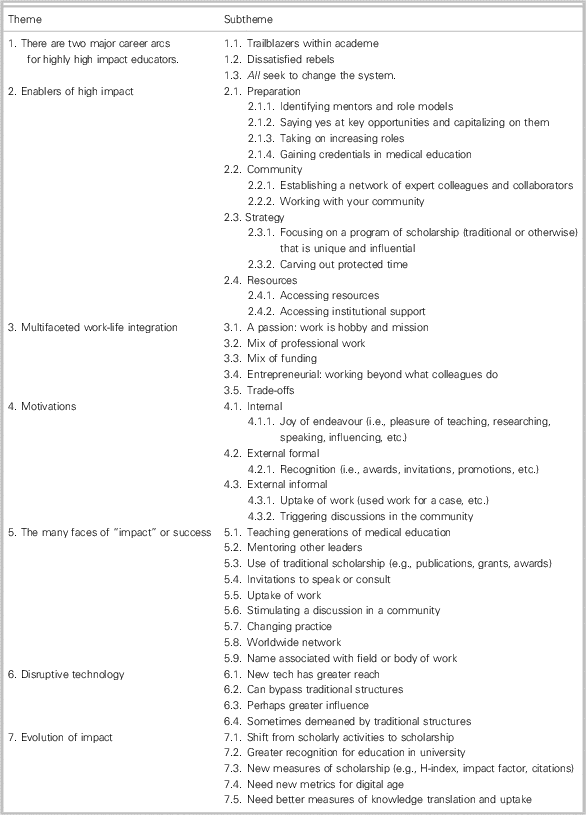INTRODUCTION
Education scholarship is a critical activity for a rapidly expanding specialty like emergency medicine (EM). According to van Melle, “Education scholarship is an umbrella term which can encompass both research and innovation in health professions education.”Reference Van Melle, Lockyer and Curran 1 In an era of major change in the way that health professionals will be trained in Canada and worldwide, EM needs more education scholars who can innovate, research, and disseminate advances in education.Reference Kohn 2 - Reference Frank, Snell and Cate 5 However, what is unclear is how EM education scholars can achieve high impact careers that influence and advance the practice of EM in ways that ultimately have a positive effect on patient care.
The Canadian Association of Emergency Physicians (CAEP) Academic Section was created in 2013 with the vision to “promote high-quality emergency patient care by conducting world-leading education and research in emergency medicine (EM).” The three committees of the CAEP Academic Section take turns leading a symposium on education,Reference Sherbino, Van Melle and Bandiera 6 - Reference Bandiera, Leblanc and Regehr 8 research,Reference Stiell, Artz and Perry 9 - Reference Perry, Snider and Artz 12 or leadership at the CAEP annual conference to present their latest findings and recommendations.Reference Lang, Artz and Wilkie 13 - Reference Petrie, Chopra and Chochinov 15 At CAEP 2016, the area of focus was education scholarship with the theme: “The Pathway to Success.” The goal of the 2016 Academic Symposium on Education Scholarship was to provide pragmatic recommendations in three areas: 1) recommended training for those pursuing academic roles in EM education, 2) recommendations on how to make an impact in medical education, and 3) the specifics on how to publish in the area of education scholarship. In this paper, we describe the results of the consensus recommendations on how to have a high impact career in medical education.
METHODOLOGY
We created an “Education Impact” working group (IWG) to identify the essential career elements of recognized medical educators who have influenced and advanced medical education, regardless of the specialty. The seven-member working group was formed from education scholars representing both EM training streams and six medical schools from across Canada. They met by teleconference 10 times from September 2015 to July 2016. The IWG developed their consensus recommendations using a systematic approach that engaged the Canadian EM community. At the outset, the IWG conducted a literature review of education scholarship and adopted the van Melle definition. We then defined education impact as: a productive scholarly career recognized as having a significant and powerful influence on the practice of others.
Using the previous definitions, the IWG members then identified individuals involved in EM education scholarship from the 17 Canadian medical schools, with a final list of individuals reviewed for completeness by the full working group. Each person on this list was contacted with the same structured request to 1) name individuals whom they would call high impact medical educators (who were not required to be physicians or emergency physicians) and to 2) identify others involved in EM scholarship (“snowball sampling”) who could participate in the consensus process. All names for the high impact educator list were collected electronically and ranked by frequency. It was decided a priori that if the names of any of the IWG were put forth they would be excluded from the rank list. The top five individuals on the rank list were interviewed by IWG members using a standard interview script. Each interviewee was asked the same series of questions (Table 1), with which they were provided in advance of the interview. Following the initial five interviews, the transcripts were coded for themes using interpretive descriptive methods by two of the working group (JRF, WJC).Reference Thorne, Reimer Kirkham and O’Flynn-Magee 16 Subsequently, the next highest ranked individual was interviewed, and this continued until sufficiency (absence of additional themes) was reached. All interviews were audio recorded, and field notes were taken.
Table 1 List of interview questions for high impact medical educators

ANALYSIS
Two independent authors (JRF, WJC) reviewed the audio recordings and field notes, and conducted an inductive analysis to identify emerging themes. These themes were presented to the full IWG for review. Themes that were felt to be similar were merged or grouped within broader themes. The themes were presented at the 2016 CAEP Academic Symposium to 90 attendees from the EM community, including practicing physicians, residents, medical students, and senior EM leaders. Participants self-selected based on their interest in the CAEP Academic Section and/or the topic. The attendees vetted the proposed themes for understanding and validity before working in small groups to provide recommendations around an assigned theme. These recommendations were then presented to the symposium attendees at-large for further discussion and refinement. At a follow-up teleconference, the themes and draft recommendations were refined by the IWG, and the recommendations were finalized and circulated to the Academic Section for final comments in August 2016. All feedback was incorporated into a final set of recommendations for the Canadian EM community.
RESULTS
Fifty-five (71%) of 77 identified EM medical educators participated. In total, 170 names of high impact educators were submitted (ranging from 1 to as many as 11 nominations per person); 102 unique names were identified as medical educators with impact, and IWG members were removed. For the interviews, theme sufficiency was reached upon completion of the ninth interview. Seven broad themes were identified, and each included from three to nine subthemes (Table 2).
Table 2 Themes identified from high impact medical educators about their career path

RECOMMENDATIONS
The IWG developed the following recommendations for EM educators who wish to have a career that influences and advances medical education, practice, and patient care:
EM educators can pursue a high impact career by leveraging either traditional academic structures or innovative career pathways
Two distinct career paths emerged from the consensus process. The first was labelled “traditional academic” and involved a career focused on developing scholarly innovations, obtaining grants, conducting research, and disseminating via traditional print journals within the infrastructure of universities. High impact educators used these activities within academe as a platform to influence the practice of other educators and practitioners, and were recognized as important scholars. The second career pathway was labelled as “innovative” and was described as a way of having impact enabled by digital technology. In the field of medical education, digital platforms (e.g., social media) were perceived as a means of reaching a broader audience in a more timely fashion than traditional channels of disseminations (e.g., print journals). The use of these new technologies helped the high impact educators support the accelerated translation and uptake of their education innovations by bypassing traditional structures.Reference Sherbino 17 , Reference Sherbino, Arora and Van Melle 18 Using the innovative pathway, they developed new organizations and digital platforms (e.g., https://www.aliem.com/ and https://www.emrap.org/) on which to innovate and widely disseminate their work. EM educators can use one or both of these career paths when deciding on their approach to having impact.
EM educators starting their education careers should have multiple senior mentors
All contributors identified the need and benefits of effective mentorship for those embarking on a career of scholarship. Mentors enable development of scholars, break down barriers to career advancement, enhance networking, and can coach junior scholars to be more high impact. It was emphasized that no single mentor can meet all of these needs, hence the “personal board of directors” concept to support aspiring scholars via nurturing by several leaders.Reference Van Melle, Lockyer and Curran 1 , Reference Humphrey 19 The nine interviewees described actively engaging in the medical education community as an essential first-step to identifying potential mentors. They described mentorships as being developed over time while working closely with more senior educators. Therefore, aspiring EM educators should seek opportunities for scholarly collaboration with seasoned educators within their focused area of interest. As soon as a mentoring relationship is established, EM educators can access their primary mentor’s broad network of colleagues and collaborators to identify additional mentors.
Early-career EM educators should immerse themselves in their area of interest and cultivate a community of practice, not limited to EM
Contributors to the consensus process highlighted the need for focus and immersion in the field of medical education for EM. The interviewed high impact educators expressed a passion for their contributions to the medical community, and each was motivated to reach beyond the typical expectations of his or her field. Aspiring EM educators need to find an area of focused interest within medical education (their “niche”), equip themselves with the training and credentialing needed to effectively engage within the community of practice, and find their unique way of contributing. Initially chosen niches are often not in the exact domain where the educator will ultimately establish high impact, but the journey of each of these interests often leads to a deeper discovery of how to influence and advance medical education. Furthermore, developing a network of expert colleagues and collaborators, as well as working with the medical education community were viewed as essential. This concept invokes parallels with other human endeavours that pursue elite performance (e.g., music, sport, chess) in that dedication and collaborations are required to truly achieve a level that is high impact.Reference Ericsson, Charness and Feltovich 20
Every academic EM department and EM teaching site should have access to an EM educator with protected time and recognition for their EM education scholarship
EM, as a rapidly growing specialty in an era of dramatic change in medical training, urgently requires a cadre of expert medical educators. The IWG recommends that every Canadian academic EM program recruit and support one or more dedicated clinician educators.Reference Sherbino, Frank and Snell 21 To enable our young specialty to be a leader and innovator in medical education, we need high impact educators to be a resource to every major EM organization.
Educators at all stages should continuously compile an impact portfolio
Contributors emphasized the need for all scholars to document their impact on an ongoing basis. More than a traditional portfolio for academic promotion (documenting publications, abstracts, and grants), the IWG identified the need for an “impact portfolio” that documented other measures of influence. This larger body of work can include such elements as evidence of invited presentations, consultations, awards and honours, mentees and graduate students, uptake of innovations, stimulated discourses in a community, changes to practice, or a named field.
CONCLUSION
The concept of high impact educational scholarship and how to achieve it was identified as a priority for the EM community. In this paper, we describe a unique set of recommendations on the essential ingredients for developing a cadre of scholarly EM educators recognized as influential and practice-changing innovators. EM leaders, educators, and aspiring educational scholars should consider how to implement this guide to enhance our specialty’s educational mission.
Acknowledgements: The background and themes of this article were presented at the 2016 Academic Symposium on Education Scholarship in Emergency Medicine on 4 June 2016 at CAEP 2016 in Québec City. The authors thank the high impact educators for providing their time and expertise (in alphabetical order): Georges Bordage, Patrick Croskerry, Kevin Eva, Mel Herbert, Brian Hodges, Michelle Lin, Lorelei Lingard, Ivan Silver, and Scott Weingart. We also thank all of the many dedicated EM educators within our community who provided names of those educators who have made an impact on them. We extend our thanks to Kelly Wyatt and Jennifer D. Artz at the CAEP office.
Competing interests: None declared.




